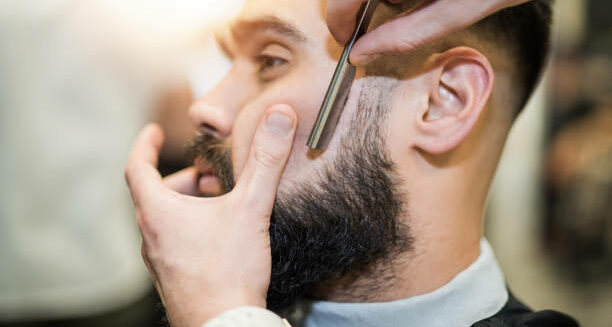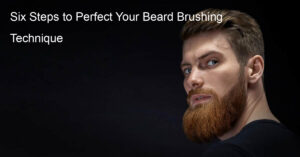Have you ever asked yourself how long your beard should be before using beard oil to maintain your facial hair? It is likely one of the top five most frequently asked concerns about beard growth and upkeep. The quick answer is that it is never too early to begin beard maintenance.
What Length Do You Need Beard Oil?
Let’s get straight to the point: Once you start to grow a beard, you should begin utilizing washing and moisturizing solutions. Even the tiniest newly grown hairs are still absorbing extra oil and debris from your skin and must be cleaned just like the rest of your hair.

KEY TAKEAWAY
It is crucial to maintain both the hair and the skin hydrated and conditioned. Dryness, irritation, and flakiness are the primary obstacles preventing many men from growing and maintaining a beard. All of these issues are resolved by beginning a conditioning program early and keeping it throughout the life of your beard.
Now you know when to start your beard oil product, but how do you know whether you should go with a liquid or a dry oil?
Liquid Beard Oil
Beard dry oil is usually suggested if you’re growing a new beard. It is absorbed more quickly and will maintain your skin and beard in good condition, no matter how long it is.
You can’t go wrong when it comes to nourishing your facial hair, even if it doesn’t hold quite as well as a dry oil. Avoid starting with too much; you don’t want to overdo it.
Beard Dry Oil
Combining combing or brushing with beard dry oil is a terrific technique to train your facial hairs to lay the way you choose. Due to the modest grip provided by beeswax, It is often recommended beard dry oil for shorter or younger beards.
PRO-TIP
It is not a styling solution or something used for a freestyle beard setup, but it is sufficient for repositioning stray hairs. As a low-temperature solid, there is no danger of over-pouring, making it somewhat more intuitive for people who are new to beard conditioning. Of course, it has the same conditioning benefits and aromas as the classic beard oil.
Having known when you should apply the beard oil. Keep reading to find out.
| Length | Beard Oil Needed |
|---|---|
| Short | 1-2 drops |
| Medium | 3-4 drops |
| Long | 5-6 drops |
| Extra-long | 7-8 drops |
When to Use Beard Oil?
Beard Oil is used every day after cleansing the face in the morning. Try applying a few additional drops of the oil later in the day or before sleeping if you reside in a drier region.
In addition, we suggest starting to use Beard Oil as soon as your facial hair begins to grow. It will promote softer hair growth and minimize itching.
Frequently Asked Questions
Is There a Risk to Using Beard Oil?
Beard Oil components may trigger unpleasant effects in some people. Oils extracted from fruits or plants are typically sensitive. However, this is a potential negative impact of any cosmetic items, not alone Beard Oil.
Fragrance combinations available in cosmetic products such as Beard Oil may irritate sensitive skin.
Can Itching Be Relieved by Using Beard Oil?
The answer is yes, Beard Oil assist halt and avoiding irritation. This itching happens when the hairs begin to curl and poke at the skin, causing a typical sort of beard itching.
Helping your skin acclimate to new growth during this period might help alleviate any dryness you might be experiencing. Softening beard hair and hydrating your face are two benefits of beard oil.
Does a Short Beard Need Beard Oil?
Both the short and long forms need oil. If you have a short hairstyle, you can probably get away without applying a balm, but it would be wise to ensure that it is healthy. However, as your beard becomes longer, you may want more balm for style and “keeping it together.”

How often should you apply beard oil?
Beard oil is a great way to keep your facial hair looking and feeling healthy. It helps to nourish the skin beneath the beard, as well as condition and soften the hair itself.
The frequency of application depends on several factors, such as the density of your beard or if you have any underlying skin conditions – but in general, it’s recommended to apply beard oil at least twice a day. In the morning, after taking a shower and getting ready for the day ahead, you should massage a few drops of beard oil into your facial hair.
This will help ensure that your facial hair is properly hydrated and conditioned throughout the day. At night before going to bed, you can use a slightly heavier application of beard oil to further nourish and condition your facial hair overnight.
If you have an especially thick or dry beard, you may benefit from adding an additional application during the day or using a higher-quality product designed specifically for chemotherapy (the study of fragrances).
How to determine the right type of beard oil for your skin type and hair texture?
When determining the right type of beard oil for your skin type and hair texture, first consider your skin’s natural oil content. If you have dry or oily skin, choose a beard oil that contains ingredients that can help balance out your skin’s natural oils.
For example, jojoba and argan oils are great for those with dryer skin while almond and coconut oils are better suited to those with oily complexions.
Next, consider your facial hair texture.
If you have thick or curly hair, look for a heavier beard oil that will provide extra conditioning and nourishment to keep it looking healthy and shiny. Those with fine or straight hair should opt for lighter oils such as grapeseed or avocado which offer a lighter layer of protection without weighing down the strands.
Consider also adding other beneficial ingredients such as vitamin E which provides extra hydration and helps protect the hair shaft from damage. Finally, look for fragranced products if you enjoy having a pleasant scent emanating from your facial hair.
How much area of your face should you cover with the beard oil when applying?
When applying beard oil, it is important to cover the entire area of your face where your facial hair grows. This means not only the length of your beard but also the skin beneath, as well as the upper lip and cheeks.
Depending on the thickness of your beard, you may need to use more or less oil to ensure adequate coverage. Generally speaking, use enough oil so that all hairs are evenly saturated throughout the entire area and that there is a thin layer left on your skin.
If you have particularly thick or unruly facial hair, you may need extra oil to ensure that each strand is properly hydrated and conditioned for a healthy appearance. Additionally, be sure to massage any excess oil into your skin for maximum moisturizing benefits.

What are some tips for applying beard oil correctly?
When applying beard oil, it is important to start by combing or brushing your beard to evenly distribute the product. This will help ensure that all of your facial hair gets an equal dose of nourishment.
Additionally, when applying the oil to your face, use a downward motion from the cheeks to the chin in order to get better coverage. It is also important to make sure you are using enough product for your specific beard type and length; if needed, add extra oil until each strand is completely covered and moisturized.
For those with thicker beards, you may need to use more oil than usual due to the higher density of the hairs. Finally, give yourself time for the product to absorb into your skin and facial hair before styling.
This will ensure that you reap all of its benefits while minimizing any mess or residue left on clothing or bedding. If possible, allow a few minutes after applying the beard oil before touching it up with a comb or brush; this will give it ample time to penetrate each strand and sink into your skin below.
With regular use of quality beard oil, you’ll soon begin noticing softer, shinier facial hair while having fewer problems with dryness and itchiness from underneath.
What are some common ingredients found in beard oil?
Beard oil is typically made up of a blend of vegetable oils, essential oils, and fragrances. Common vegetable oils used in beard oil include jojoba, argan, almond, and coconut oil; these natural ingredients provide essential fatty acids which help to nourish the skin beneath the beard while conditioning and softening the hair itself.
Essential oils such as eucalyptus, lavender, and tea tree are also often used in beard oil due to their antibacterial, antiseptic, and antioxidant properties which can help promote healthy facial hair growth. In addition, many manufacturers add scented fragrances to their formulations to give the product a pleasant aroma.
While some prefer light, natural scents such as sandalwood or citrus, others opt for more robust options like cedarwood or bergamot. Regardless of your preference, all of these ingredients work together to create an effective product that helps keep your facial hair looking and feeling it’s very best!
Can you use beard oil on your head hair as well?
Yes, you can use beard oil on your head hair. This is especially beneficial for those with curly or wavy locks as it can help to nourish the scalp and keep their tresses looking soft and shiny.
Additionally, beard oil is a great way to protect the hair from environmental stressors such as sun exposure and pollution while helping to promote healthy growth. Beard oil is also a great choice for those with dry scalp issues or dandruff, as its natural oils provide deep nourishment that helps to restore moisture and hydrate the scalp.
In addition to using beard oil, it is important to pair it with a mild shampoo specifically designed for your hair type in order to ensure that all dirt and buildup are properly removed without stripping away any of its natural oils.
Finally, regular massage of your scalp along with the application of beard oil helps promote improved blood circulation which can lead to thicker and healthier head hair in the long run.
Wrap Up
It would be best to begin caring for your beard on day one, including cleaning and nourishing the hair and maintaining the skin hydrated. Will you choose the mild hold that the beard dry oil provides and train your hair as they begin to grow?
Alternatively, would you want to use liquid beard oil and allow your hair to grow normally? You will not be upset with any option, and you will put your beard in the healthiest condition possible to stimulate development.














